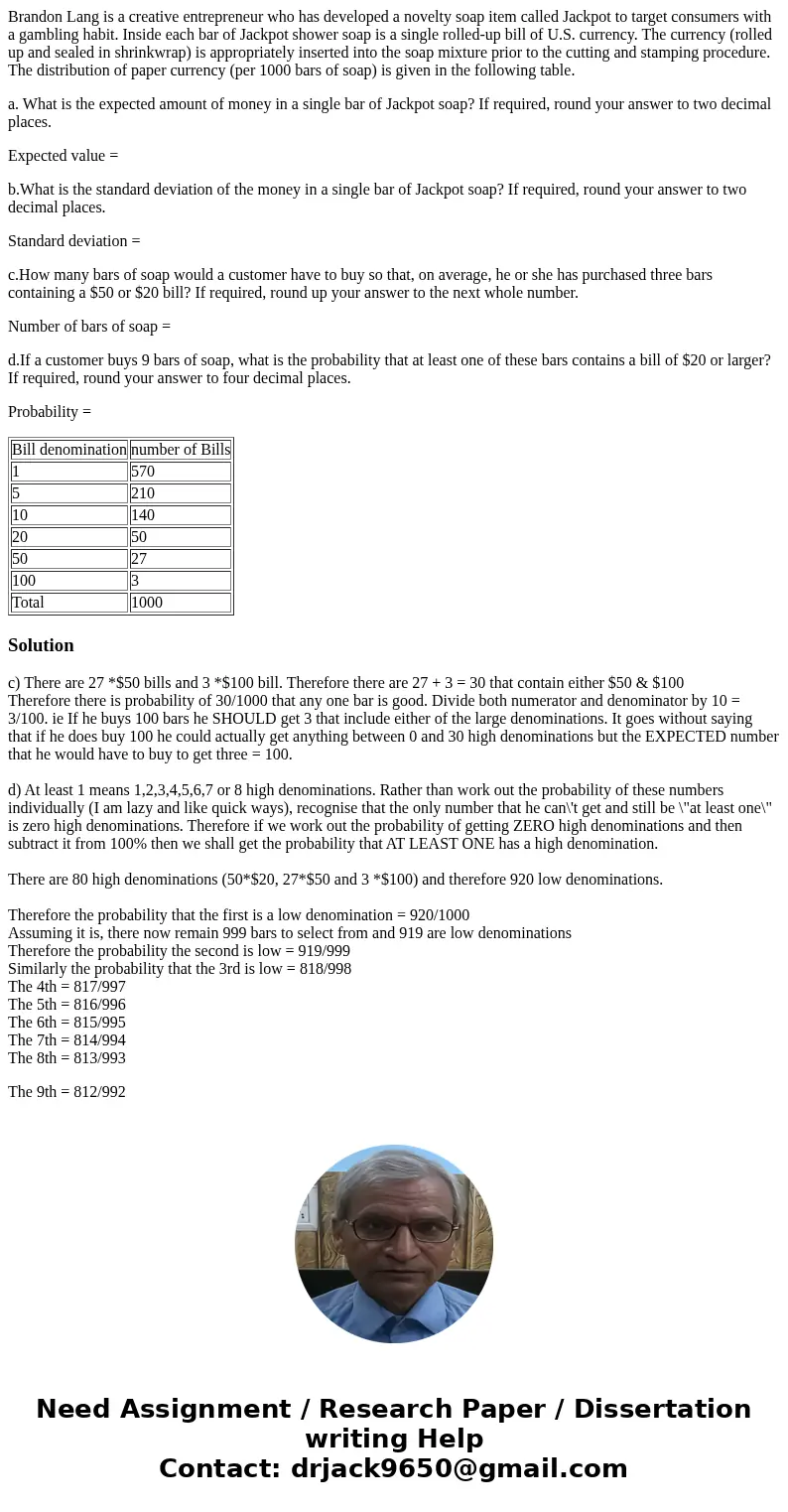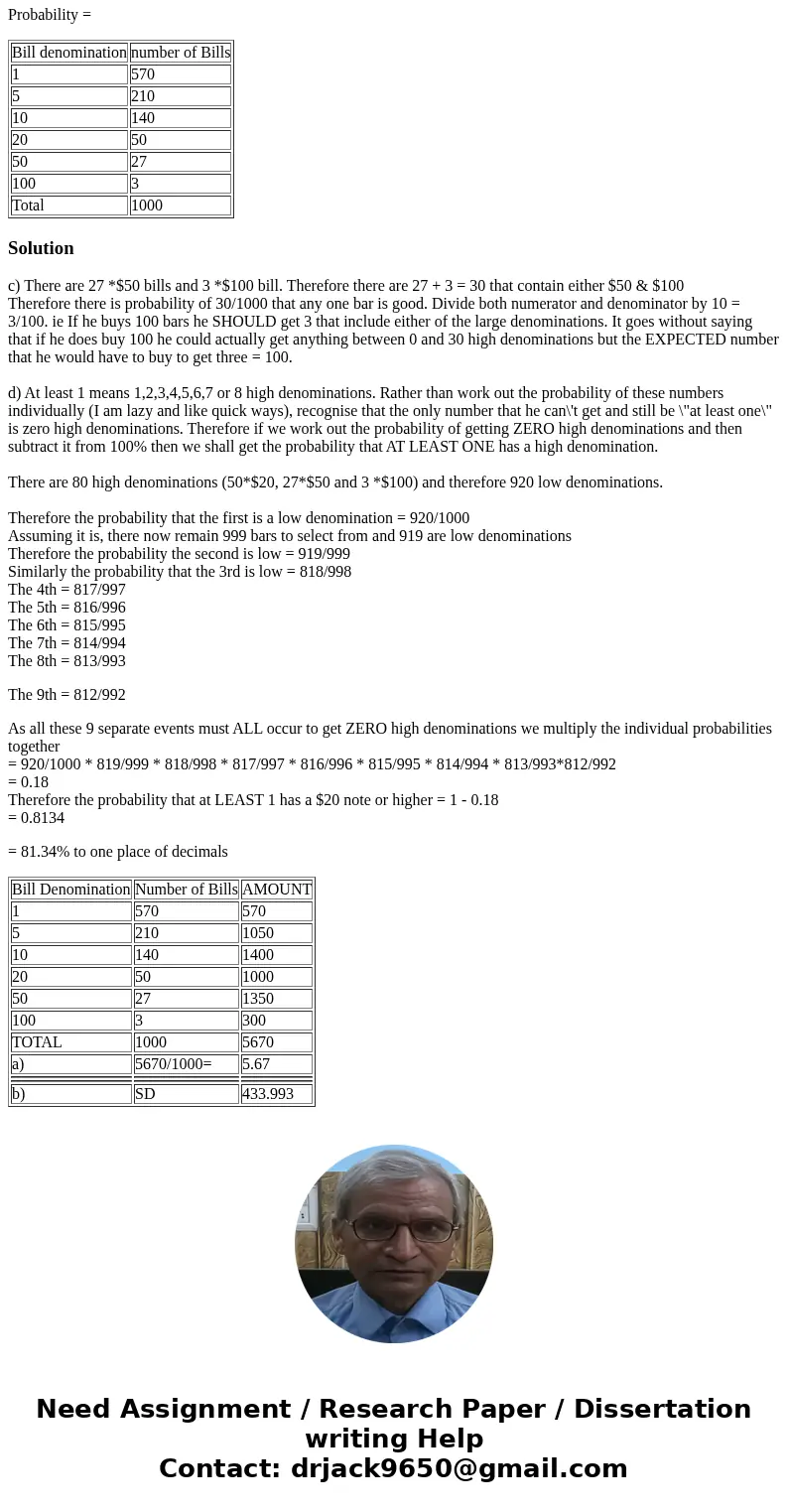Brandon Lang is a creative entrepreneur who has developed a
Brandon Lang is a creative entrepreneur who has developed a novelty soap item called Jackpot to target consumers with a gambling habit. Inside each bar of Jackpot shower soap is a single rolled-up bill of U.S. currency. The currency (rolled up and sealed in shrinkwrap) is appropriately inserted into the soap mixture prior to the cutting and stamping procedure. The distribution of paper currency (per 1000 bars of soap) is given in the following table.
a. What is the expected amount of money in a single bar of Jackpot soap? If required, round your answer to two decimal places.
Expected value =
b.What is the standard deviation of the money in a single bar of Jackpot soap? If required, round your answer to two decimal places.
Standard deviation =
c.How many bars of soap would a customer have to buy so that, on average, he or she has purchased three bars containing a $50 or $20 bill? If required, round up your answer to the next whole number.
Number of bars of soap =
d.If a customer buys 9 bars of soap, what is the probability that at least one of these bars contains a bill of $20 or larger? If required, round your answer to four decimal places.
Probability =
| Bill denomination | number of Bills |
| 1 | 570 |
| 5 | 210 |
| 10 | 140 |
| 20 | 50 |
| 50 | 27 |
| 100 | 3 |
| Total | 1000 |
Solution
c) There are 27 *$50 bills and 3 *$100 bill. Therefore there are 27 + 3 = 30 that contain either $50 & $100
Therefore there is probability of 30/1000 that any one bar is good. Divide both numerator and denominator by 10 = 3/100. ie If he buys 100 bars he SHOULD get 3 that include either of the large denominations. It goes without saying that if he does buy 100 he could actually get anything between 0 and 30 high denominations but the EXPECTED number that he would have to buy to get three = 100.
d) At least 1 means 1,2,3,4,5,6,7 or 8 high denominations. Rather than work out the probability of these numbers individually (I am lazy and like quick ways), recognise that the only number that he can\'t get and still be \"at least one\" is zero high denominations. Therefore if we work out the probability of getting ZERO high denominations and then subtract it from 100% then we shall get the probability that AT LEAST ONE has a high denomination.
There are 80 high denominations (50*$20, 27*$50 and 3 *$100) and therefore 920 low denominations.
Therefore the probability that the first is a low denomination = 920/1000
Assuming it is, there now remain 999 bars to select from and 919 are low denominations
Therefore the probability the second is low = 919/999
Similarly the probability that the 3rd is low = 818/998
The 4th = 817/997
The 5th = 816/996
The 6th = 815/995
The 7th = 814/994
The 8th = 813/993
The 9th = 812/992
As all these 9 separate events must ALL occur to get ZERO high denominations we multiply the individual probabilities together
= 920/1000 * 819/999 * 818/998 * 817/997 * 816/996 * 815/995 * 814/994 * 813/993*812/992
= 0.18
Therefore the probability that at LEAST 1 has a $20 note or higher = 1 - 0.18
= 0.8134
= 81.34% to one place of decimals
| Bill Denomination | Number of Bills | AMOUNT |
| 1 | 570 | 570 |
| 5 | 210 | 1050 |
| 10 | 140 | 1400 |
| 20 | 50 | 1000 |
| 50 | 27 | 1350 |
| 100 | 3 | 300 |
| TOTAL | 1000 | 5670 |
| a) | 5670/1000= | 5.67 |
| b) | SD | 433.993 |


 Homework Sourse
Homework Sourse